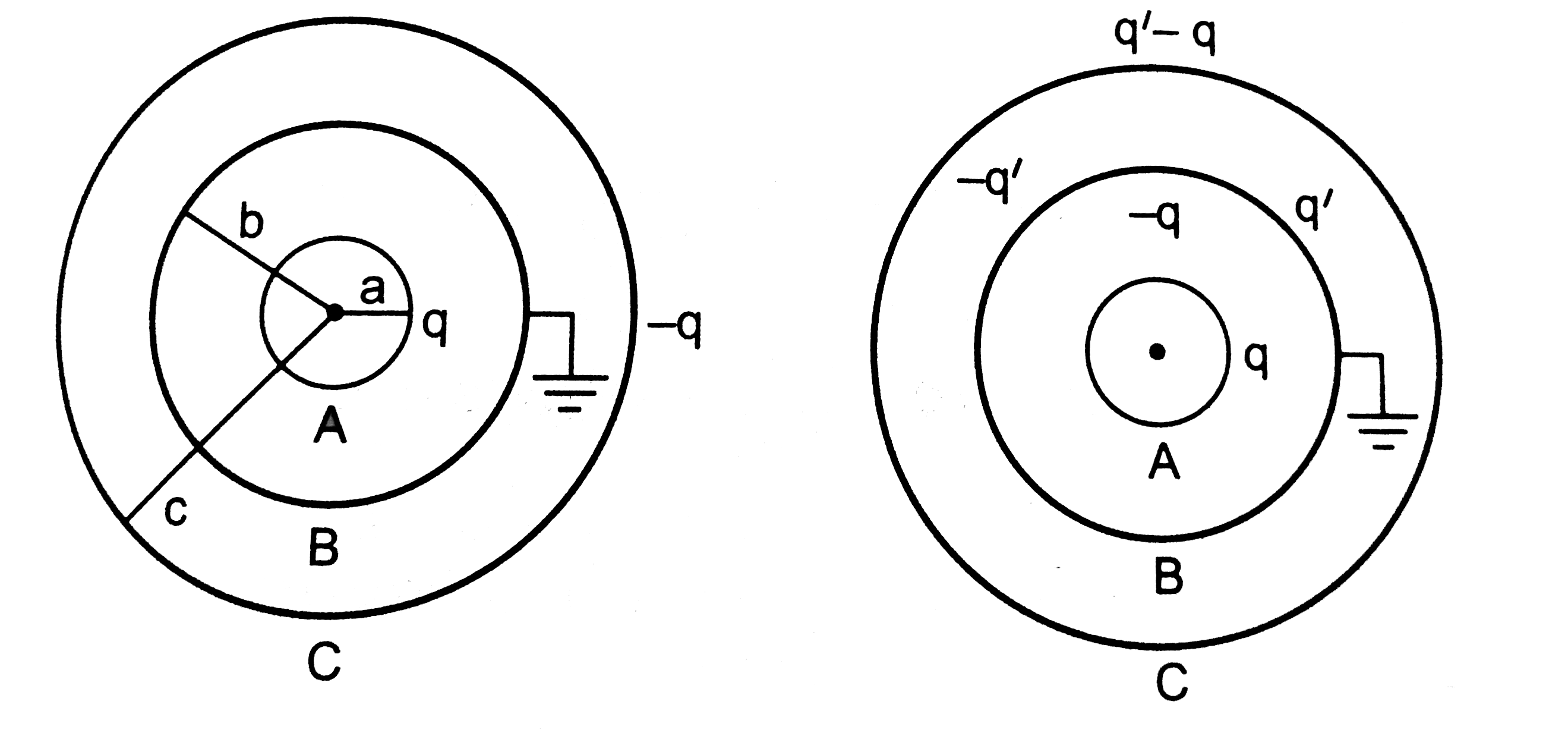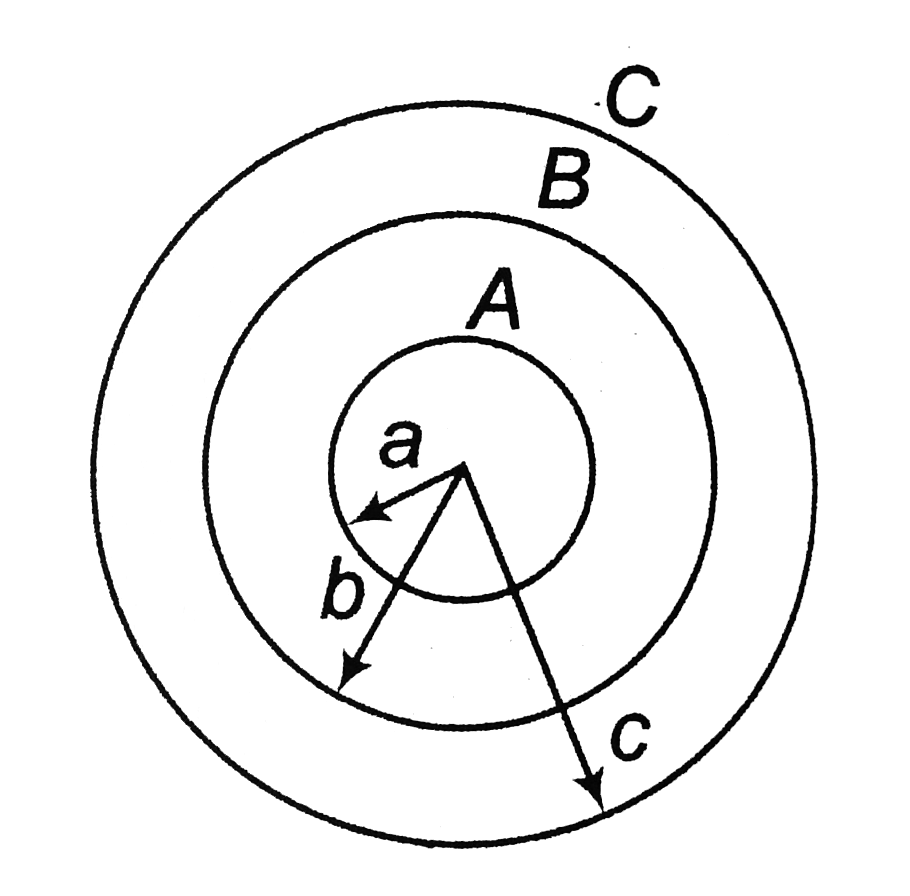Three concentric spherical metallic shells A, B and C of radii a, b and c (a < b < c) have surface charge densities σ, −σ and σ respectively.
(i) Find the potential of the three shells A, B and C.
(ii) If the shells A and C are at the same potential, obtain the relation between the radii a, b and c.
The correct Answer is:A, B, C
To solve the given problem, we will find the potentials of the three concentric spherical metallic shells A, B, and C, and then derive the relationship between their radii if the potentials of shells A and C are equal.
Step 1: Calculate the Charge on Each Shell
The surface charge densities are given as follows:
- Shell A has surface charge density σ
- Shell B has surface charge density −σ
- Shell C has surface charge density σ
The charges on the shells can be calculated using the formula:
Q=σ×Surface Area
The surface area of a sphere is given by 4πr2.
Thus, the charges are:
- Charge on shell A:
QA=σ×4πa2
- Charge on shell B:
QB=−σ×4πb2
- Charge on shell C:
QC=σ×4πc2
Step 2: Calculate the Potential of Shell A
The potential VA at a point inside shell A (which is also inside shells B and C) is given by:
VA=K⋅QA⋅1a+VB+VC
Where K=14πϵ0.
Since the potential due to a shell is constant inside it, we can express the potential as:
VA=K⋅QA⋅1a+K⋅QB⋅1b+K⋅QC⋅1c
Substituting the values of QA, QB, and QC:
VA=σϵ0(a+b+c)
Step 3: Calculate the Potential of Shell B
For shell B, which is between shells A and C, the potential VB is given by:
VB=K⋅QA⋅1b+K⋅QC⋅1c
Substituting the values:
VB=σϵ0(a2b+c2c)
Step 4: Calculate the Potential of Shell C
For shell C, which is outside both shells A and B, the potential VC is given by:
VC=K⋅(QA+QB+QC)⋅1c
Substituting the values:
VC=σϵ0(a2+b2+c2c)
Step 5: Equate Potentials of Shell A and Shell C
If the potentials of shells A and C are equal, we have:
VA=VC
Substituting the expressions for VA and VC:
σϵ0(a+b+c)=σϵ0(a2+b2+c2c)
Cancelling σϵ0 from both sides:
a+b+c=a2+b2+c2c
Multiplying through by c:
c(a+b+c)=a2+b2+c2
Rearranging gives:
a2+b2+c2−ac−bc−c2=0
This simplifies to:
c=a+b
Final Answers
(i) The potentials of the shells are:
- VA=σϵ0(a+b+c)
- VB=σϵ0(a2b+c)
- VC=σϵ0(a2+b2+c2c)
(ii) The relation between the radii is:
c=a+b
The surface charge densities are given as follows:
- Shell A has surface charge density σ
- Shell B has surface charge density −σ
- Shell C has surface charge density σ
Q=σ×Surface Area
The surface area of a sphere is given by 4πr2.
- Charge on shell A:
QA=σ×4πa2
- Charge on shell B:
QB=−σ×4πb2
- Charge on shell C:
QC=σ×4πc2
The potential VA at a point inside shell A (which is also inside shells B and C) is given by:
VA=K⋅QA⋅1a+VB+VC
Where K=14πϵ0.
VA=K⋅QA⋅1a+K⋅QB⋅1b+K⋅QC⋅1c
Substituting the values of QA, QB, and QC:
VA=σϵ0(a+b+c)
For shell B, which is between shells A and C, the potential VB is given by:
VB=K⋅QA⋅1b+K⋅QC⋅1c
Substituting the values:
VB=σϵ0(a2b+c2c)
For shell C, which is outside both shells A and B, the potential VC is given by:
VC=K⋅(QA+QB+QC)⋅1c
Substituting the values:
VC=σϵ0(a2+b2+c2c)
If the potentials of shells A and C are equal, we have:
VA=VC
Substituting the expressions for VA and VC:
σϵ0(a+b+c)=σϵ0(a2+b2+c2c)
Cancelling σϵ0 from both sides:
a+b+c=a2+b2+c2c
Multiplying through by c:
c(a+b+c)=a2+b2+c2
Rearranging gives:
a2+b2+c2−ac−bc−c2=0
This simplifies to:
c=a+b
(i) The potentials of the shells are:
- VA=σϵ0(a+b+c)
- VB=σϵ0(a2b+c)
- VC=σϵ0(a2+b2+c2c)
c=a+b
Topper's Solved these Questions
- ELECTROSTATICSBOOK - DC PANDEY ENGLISHCHAPTER - ELECTROSTATICSEXERCISE - SUBJECTIVE_TYPE
6 Videos
- ELECTROSTATICSBOOK - DC PANDEY ENGLISHCHAPTER - ELECTROSTATICSEXERCISE - Check point 1.1
10 Videos
- ELECTROSTATICSBOOK - DC PANDEY ENGLISHCHAPTER - ELECTROSTATICSEXERCISE - Level 1 Objective
82 Videos
- ELECTROSTATIC POTENTIAL AND CAPACITORSBOOK - DC PANDEY ENGLISHCHAPTER - ELECTROSTATIC POTENTIAL AND CAPACITORSEXERCISE - (C) Chapter exercises
50 Videos
- GRAVITATIONBOOK - DC PANDEY ENGLISHCHAPTER - GRAVITATIONEXERCISE - All Questions
135 Videos
Similar Questions
Three concentric spherical metallic spheres A,B and C of radii a,b and c(a<b<c) have surface charge densities σ,−σ and σ respectively.
View SolutionFigure shows three concentric thin spherical shells A, B and C of radii a, b and c respectively. The shells A and C are given charges q and -q respectively and the shell B is earthed. Find the charges appearing on the surfaces of B and C.

View SolutionFigure shows three concentric thin spherical shells A, B and C of radii a, b and c respectively. The shells A and C are given charges q and -q respectively and the shell B is earthed. Find the charges appearing on the surfaces of B and C.

View SolutionThree concentric spherical metallic shells A,B,andC of radii a,b,andc(a<b<c) have surface charge densities σ,−σ and σ, respectively.
If VA,VB and VC are potential of shells A, B and C, respectively, match the columns
Column AColumn Ba.VAi.σε0[a2−b2+c2c]b.VBii.σ2ε0[a2b−b+c]c.VCiii.σε0[a−b+c]
View SolutionFigure shows three concentric thin spherical shells A, B and C of radii a, b, and c. The shells A and C are given charge q and -q, respectively, and shell B is earthed. Then,
View SolutionThree spherical shells of masses M, 2M and 3M have radii R, 3R and 4R as shows in figure. Find net potential at point P,
View SolutionThree concentric spherical metallic shells A,B and C of radii a,b and c (a<b<c) have surface charge densities σ,−σandσ respectively.
If the potential of shell B is VB=σ∈0(anb−b+c) and the potential of shell C is VC=σ∈0(anc−bnc+c) then n is .
View SolutionIf a2+b2+c2−ab−bc−ca=0, then find the relation between a,b and c
View SolutionThree concentric metallic spherical shell A,B and C or radii a,b and c(a<b<c) have surface charge densities −σ,+σand−σ. Respectively. The potential of shel A is :
View SolutionThree concentric conducting shells A,B and C of radii a,b and c are as shown in figure. A dielectric of dielectric constant K is filled between A and B. Find the capacitance between A and C.

View Solution
